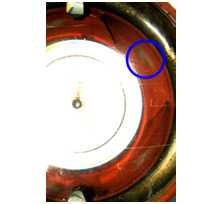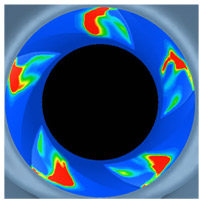Newsletter 2012.12 Index
Theme : "Fluid Machinery in Industry"
| Back | |
Investigation of the root cause phenomena in the pump by using the flow visualization technologies
- Hybrid method of experiment and CFD -
|
Abstract
Firstly, the flow instability in a low specific speed mixed-flow pump, having a positive slope of head-flow characteristics was investigated. Based on the static pressure measurement, it was found that a rotating stall in the vaned diffuser occurs at the partial flow rate. A dynamic Particle Image Velocimetry (DPIV) measurement (shown in Fig. 1) and the numerical simulation were conducted in order to investigate the flow fields in detail. As a result, the diffuser rotating stall was simulated even by Computational Fluid Dynamics (CFD) and the calculated periodic flow patterns agree well with the measured ones by DPIV (Figs. 2 and 3). It is clarified that a periodical large scaled backflow, generated at the leading edge of the suction surface of the diffuser vane, causes the instability of pump operation. Furthermore, the growth of the strong vortex at the leading edge of the diffuser vane induces the strong backflow from the diffuser outlet to the inlet. The scale of one stall cell is covered over four-passages in total thirteen vane-passages as shown in Figs. 3(a) and (b). Based on the CFD results, we focused on the strength of the backflow at the vaned-diffuser inlet. Then, we conducted parameter study using CFD and improved the characteristic instability.
Secondary, the numerical cavitation prediction methods of pump performance drop and erosion area by using a commercial CFD code are presented. A centrifugal boiler feed-pump with a double-suction type was tested and the cavitation characteristics were visualized and compared with the calculated results.As a result, the calculated pump performance drop and cavitation behavior qualitatively agree well with the experimental ones. In addition, simple cavitation erosion indices were applied to estimate the erosion area. The paint erosion test was conducted and compared with the calculated results. One of cavitation erosion indices is in good agreement with the experiment as shown in Figs. 4 and 5. Then, we investigated the important pump design parameter by using cavitation CFD and improved pump performance. It is concluded that the present numerical cavitation prediction method is available at a design process of the pump.
Key Words
Rotating stall, Cavitation, Flow instability, Pump, Vaned diffuser, PIV, CFD
Figures

Fig. 1 Schematic view of a dynamic PIV measurement system
 |
|
| (a) t*=8.10, Normal flow condition | (b) t*=10.68, Stall core |
 |
|
| (c) t*=12.0, Backflow condition | (d) t*=12.6, Blocked condition |
| Fig. 2 Instantaneous velocity vectors at the inlet of the vaned diffuser | |
 |
|
| (a) Instantaneous velocity vectors | (b) Instantaneous static pressure contour map |
| Fig. 3 CFD results near the casing | |
 |
 |
| (a) Experiment | (b) CFD |
| Fig. 4 Comparison of cavitation erosion area between experiment and CFD at QBEP | |
 |
 |
| (a) Experiment | (b) CFD |
| Fig. 5 Comparison of cavitation erosion area between experiment and CFD at partial flow rate | |


